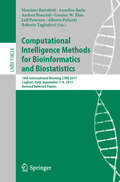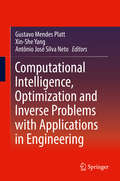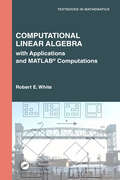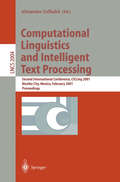- Table View
- List View
Computational Intelligence in Reliability Engineering: Evolutionary Techniques in Reliability Analysis and Optimization (Studies in Computational Intelligence #39)
by Gregory LevitinThis book covers the recent applications of computational intelligence techniques in reliability engineering. This volume contains a survey of the contributions made to the optimal reliability design literature in recent years. It also contains chapters devoted to different applications of a genetic algorithm in reliability engineering and to combinations of this algorithm with other computational intelligence techniques.
Computational Intelligence in Time Series Forecasting: Theory and Engineering Applications (Advances in Industrial Control)
by Ajoy K. Palit Dobrivoje PopovicForesight in an engineering business can make the difference between success and failure, and can be vital to the effective control of industrial systems. The authors of this book harness the power of intelligent technologies individually and in combination.
Computational Intelligence Methods for Bioinformatics and Biostatistics: 12th International Meeting, CIBB 2015, Naples, Italy, September 10-12, 2015, Revised Selected Papers (Lecture Notes in Computer Science #9874)
by Claudia Angelini Paola M. V. Rancoita Stefano RovettaThis book constitutes the thoroughly refereed post-conference proceedings of the 12th International Meeting on Computational Intelligence Methods for Bioinformatics and Biostatistics, CIBB 2015, held in Naples, Italy, in September, 2015. The 21 revised full papers presented were carefully reviewed and selected from 24 submissions. They present problems concerning computational techniques in bioinformatics, systems biology and medical informatics discussing cutting edge methodologies and accelerate life science discoveries, as well as novel challenges with an high impact on molecular biology and translational medicine.
Computational Intelligence Methods for Bioinformatics and Biostatistics: 14th International Meeting, CIBB 2017, Cagliari, Italy, September 7-9, 2017, Revised Selected Papers (Lecture Notes in Computer Science #10834)
by Massimo Bartoletti Annalisa Barla Andrea Bracciali Gunnar W. Klau Leif Peterson Alberto Policriti Roberto TagliaferriThis book constitutes the thoroughly refereed post-conference proceedings of the 14th International Meeting on Computational. Intelligence Methods for Bioinformatics and Biostatistics, CIBB 2017, held in Cagliari, Italy, in September 2017.The 19 revised full papers presented were carefully reviewed and selected from 44 submissions. The papers deal with the application of computational intelligence to open problems in bioinformatics, biostatistics, systems and synthetic biology, medical informatics, computational approaches to life sciences in general.
Computational Intelligence Methods for Bioinformatics and Biostatistics: 13th International Meeting, CIBB 2016, Stirling, UK, September 1-3, 2016, Revised Selected Papers (Lecture Notes in Computer Science #10477)
by Andrea Bracciali Giulio Caravagna David Gilbert Roberto TagliaferriThis book constitutes the thoroughly refereed post-conference proceedings of the 13th International Meeting on Computational Intelligence Methods for Bioinformatics and Biostatistics, CIBB 2016, held in Stirling, UK, in September 2016. The 19 revised full papers and 6 keynotes abstracts presented were carefully reviewed and selected from 61 submissions. The papers deal with the application of computational intelligence to open problems in bioinformatics, biostatistics, systems and synthetic biology, medicalinformatics, computational approaches to life sciences in general
Computational Intelligence, Optimization and Inverse Problems with Applications in Engineering
by Gustavo Mendes Platt Xin-She Yang Antônio José Silva NetoThis book focuses on metaheuristic methods and its applications to real-world problems in Engineering. The first part describes some key metaheuristic methods, such as Bat Algorithms, Particle Swarm Optimization, Differential Evolution, and Particle Collision Algorithms. Improved versions of these methods and strategies for parameter tuning are also presented, both of which are essential for the practical use of these important computational tools. The second part then applies metaheuristics to problems, mainly in Civil, Mechanical, Chemical, Electrical, and Nuclear Engineering. Other methods, such as the Flower Pollination Algorithm, Symbiotic Organisms Search, Cross-Entropy Algorithm, Artificial Bee Colonies, Population-Based Incremental Learning, Cuckoo Search, and Genetic Algorithms, are also presented. The book is rounded out by recently developed strategies, or hybrid improved versions of existing methods, such as the Lightning Optimization Algorithm, Differential Evolution with Particle Collisions, and Ant Colony Optimization with Dispersion – state-of-the-art approaches for the application of computational intelligence to engineering problems.The wide variety of methods and applications, as well as the original results to problems of practical engineering interest, represent the primary differentiation and distinctive quality of this book. Furthermore, it gathers contributions by authors from four countries – some of which are the original proponents of the methods presented – and 18 research centers around the globe.
Computational Intelligence Systems and Applications: Neuro-Fuzzy and Fuzzy Neural Synergisms (Studies in Fuzziness and Soft Computing #86)
by Marian B. GorzalczanyTraditional Artificial Intelligence (AI) systems adopted symbolic processing as their main paradigm. Symbolic AI systems have proved effective in handling problems characterized by exact and complete knowledge representation. Unfortunately, these systems have very little power in dealing with imprecise, uncertain and incomplete data and information which significantly contribute to the description of many real world problems, both physical systems and processes as well as mechanisms of decision making. Moreover, there are many situations where the expert domain knowledge (the basis for many symbolic AI systems) is not sufficient for the design of intelligent systems, due to incompleteness of the existing knowledge, problems caused by different biases of human experts, difficulties in forming rules, etc. In general, problem knowledge for solving a given problem can consist of an explicit knowledge (e.g., heuristic rules provided by a domain an implicit, hidden knowledge "buried" in past-experience expert) and numerical data. A study of huge amounts of these data (collected in databases) and the synthesizing of the knowledge "encoded" in them (also referred to as knowledge discovery in data or data mining), can significantly improve the performance of the intelligent systems designed.
Computational Intelligence, Theory and Applications: International Conference 9th Fuzzy Days in Dortmund, Germany, Sept. 18-20, 2006 Proceedings (Advances in Intelligent and Soft Computing #38)
by Bernd ReuschThis book constitutes the refereed proceedings of the 9th Dortmund Fuzzy Days, Dortmund, Germany, 2006. This conference has established itself as an international forum for the discussion of new results in the field of Computational Intelligence. The papers presented here, all thoroughly reviewed, are devoted to foundational and practical issues in fuzzy systems, neural networks, evolutionary algorithms, and machine learning and thus cover the whole range of computational intelligence.
Computational Intelligence. Theory and Applications: International Conference, 7th Fuzzy Days Dortmund, Germany, October 1-3, 2001 Proceedings (Lecture Notes in Computer Science #2206)
by Bernd ReuschTen years of ,,Fuzzy Days“ in Dortmund! What started as a relatively small workshop in 1991 has now become one of the best known smaller conferences on Computational Intelligence in the world. It fact, it was (to my best knowledge) the ?rst conference to use this term, in 1994, although I confess that another, larger conference was announced ?rst and the trade mark “Computational Intelligence was not coined in Dortmund. I believe, that the success of this conference is grounded on the quality of its reviewedandinvitedpapersaswellasitsgoodorganization. Fromthebeginning, we have sent every paper anonymously to ?ve referees, and we have always accepted only around 50% of the papers sent in. This year it was a little less than that. I would like to thank everybody who helped us by considering Dortmund’s Fuzzy Days as the conference at which to appear. I know that among the - stracts not accepted there were some quite good ones, but we were restricted to a ?xed number. I also know that referees do a good job but cannot always judge wisely from abstracts. Hence my apologies to those who did not make it this year. Please try again! I would like to point out that our conference also has a good regional re- tation. I am grateful to the City of Dortmund, its Lord Mayor Dr. Langemeyer, the Dortmund project, the DFG – Deutsche Forschungsgemeinschaft, the KVR – Kommunalverband Ruhrgebiet, the Martin-Schmeißer-Stiftung, and the C- line AG/Quantum GmbH for their valuable support.
A Computational Introduction to Digital Image Processing
by Alasdair McAndrewHighly Regarded, Accessible Approach to Image Processing Using Open-Source and Commercial SoftwareA Computational Introduction to Digital Image Processing, Second Edition explores the nature and use of digital images and shows how they can be obtained, stored, and displayed. Taking a strictly elementary perspective, the book only covers topics that
Computational Invariant Theory (Encyclopaedia of Mathematical Sciences #130)
by Harm Derksen Gregor KemperThis book is about the computational aspects of invariant theory. Of central interest is the question how the invariant ring of a given group action can be calculated. Algorithms for this purpose form the main pillars around which the book is built. There are two introductory chapters, one on Gröbner basis methods and one on the basic concepts of invariant theory, which prepare the ground for the algorithms. Then algorithms for computing invariants of finite and reductive groups are discussed. Particular emphasis lies on interrelations between structural properties of invariant rings and computational methods. Finally, the book contains a chapter on applications of invariant theory, covering fields as disparate as graph theory, coding theory, dynamical systems, and computer vision.The book is intended for postgraduate students as well as researchers in geometry, computer algebra, and, of course, invariant theory. The text is enriched with numerous explicit examples which illustrate the theory and should be of more than passing interest.More than ten years after the first publication of the book, the second edition now provides a major update and covers many recent developments in the field. Among the roughly 100 added pages there are two appendices, authored by Vladimir Popov, and an addendum by Norbert A'Campo and Vladimir Popov.
Computational Invariant Theory (Encyclopaedia of Mathematical Sciences #130)
by Harm Derksen Gregor KemperThis book, the first volume of a subseries on "Invariant Theory and Algebraic Transformation Groups", provides a comprehensive and up-to-date overview of the algorithmic aspects of invariant theory. Numerous illustrative examples and a careful selection of proofs make the book accessible to non-specialists.
Computational Issues in Fluid Construction Grammar (Lecture Notes in Computer Science #7249)
by Luc SteelsThis state-of-the-art-survey documents the Fluid Construction Grammar (FCG), a new formalism for the representation of lexicons and grammars, which has been used in a wide range of case studies for different languages, both for studying specific grammatical phenomena and design patterns, as for investigating language learning and language evolution. The book focuses on the many complex computational issues that arise when writing challenging real world grammars and hence emphasises depth of analysis rather than broad scope. The volume contains 13 contributions organized in 5 parts from "Basic", and "Implementation", over "Case Studies", and "Formal Analysis", up to 3 papers presenting a "Conclusion".
Computational Issues in High Performance Software for Nonlinear Optimization
by Almerico Murli Gerardo ToraldoComputational Issues in High Performance Software for Nonlinear Research brings together in one place important contributions and up-to-date research results in this important area. Computational Issues in High Performance Software for Nonlinear Research serves as an excellent reference, providing insight into some of the most important research issues in the field.
Computational Kinematics ’95: Proceedings of the Second Workshop on Computational Kinematics, held in Sophia Antipolis, France, September 4–6, 1995 (Solid Mechanics and Its Applications #40)
by J. P. Merlet Bahram RavaniThe aim of this book is to provide an account of the state of the art in Com putational Kinematics. We understand here under this term that branch of kinematics research involving intensive computations not only of the nu merical type, but also of symbolic as well as geometric nature. Research in kinematics over the last decade has been remarkably ori ented towards the computational aspects of kinematics problems. In fact, this work has been prompted by the need to answer fundamental questions such as the number of solutions, whether real or complex, that a given problem can admit as well as computational algorithms to support geo metric analysis. Problems of the first kind occur frequently in the analysis and synthesis of kinematic chains, when fine displacements are considered. The associated models, that are derived from kinematic relations known as closure equations, lead to systems of nonlinear algebraic equations in the variables or parameters sought. The algebraic equations at hand can take the form of multivariate polynomials or may involve trigonometric functions of unknown angles.
Computational Learning Theory: 4th European Conference, EuroCOLT'99 Nordkirchen, Germany, March 29-31, 1999 Proceedings (Lecture Notes in Computer Science #1572)
by Paul Fischer Hans U. SimonComputational Learning Theory: 14th Annual Conference on Computational Learning Theory, COLT 2001 and 5th European Conference on Computational Learning Theory, EuroCOLT 2001, Amsterdam, The Netherlands, July 16-19, 2001, Proceedings (Lecture Notes in Computer Science #2111)
by David Helmbold Bob WilliamsonComputational Learning Theory: 15th Annual Conference on Computational Learning Theory, COLT 2002, Sydney, Australia, July 8-10, 2002. Proceedings (Lecture Notes in Computer Science #2375)
by Jyrki Kivinen Robert H. SloanComputational Line Geometry (Mathematics and Visualization)
by Helmut Pottmann Johannes WallnerFrom the reviews: " A unique and fascinating blend, which is shown to be useful for a variety of applications, including robotics, geometrical optics, computer animation, and geometric design. The contents of the book are visualized by a wealth of carefully chosen illustrations, making the book a shear pleasure to read, or even to just browse in." Mathematical Reviews
Computational Linear Algebra: with Applications and MATLAB® Computations (Textbooks in Mathematics)
by Robert E. WhiteCourses on linear algebra and numerical analysis need each other. Often NA courses have some linear algebra topics, and LA courses mention some topics from numerical analysis/scientific computing. This text merges these two areas into one introductory undergraduate course. It assumes students have had multivariable calculus. A second goal of this text is to demonstrate the intimate relationship of linear algebra to applications/computations.A rigorous presentation has been maintained. A third reason for writing this text is to present, in the first half of the course, the very important topic on singular value decomposition, SVD. This is done by first restricting consideration to real matrices and vector spaces. The general inner product vector spaces are considered starting in the middle of the text.The text has a number of applications. These are to motivate the student to study the linear algebra topics. Also, the text has a number of computations. MATLAB® is used, but one could modify these codes to other programming languages. These are either to simplify some linear algebra computation, or to model a particular application.
Computational Linear Algebra: with Applications and MATLAB® Computations (Textbooks in Mathematics)
by Robert E. WhiteCourses on linear algebra and numerical analysis need each other. Often NA courses have some linear algebra topics, and LA courses mention some topics from numerical analysis/scientific computing. This text merges these two areas into one introductory undergraduate course. It assumes students have had multivariable calculus. A second goal of this text is to demonstrate the intimate relationship of linear algebra to applications/computations.A rigorous presentation has been maintained. A third reason for writing this text is to present, in the first half of the course, the very important topic on singular value decomposition, SVD. This is done by first restricting consideration to real matrices and vector spaces. The general inner product vector spaces are considered starting in the middle of the text.The text has a number of applications. These are to motivate the student to study the linear algebra topics. Also, the text has a number of computations. MATLAB® is used, but one could modify these codes to other programming languages. These are either to simplify some linear algebra computation, or to model a particular application.
Computational Linear and Commutative Algebra
by Martin Kreuzer Lorenzo RobbianoThis book combines, in a novel and general way, an extensive development of the theory of families of commuting matrices with applications to zero-dimensional commutative rings, primary decompositions and polynomial system solving. It integrates the Linear Algebra of the Third Millennium, developed exclusively here, with classical algorithmic and algebraic techniques. Even the experienced reader will be pleasantly surprised to discover new and unexpected aspects in a variety of subjects including eigenvalues and eigenspaces of linear maps, joint eigenspaces of commuting families of endomorphisms, multiplication maps of zero-dimensional affine algebras, computation of primary decompositions and maximal ideals, and solution of polynomial systems. This book completes a trilogy initiated by the uncharacteristically witty books Computational Commutative Algebra 1 and 2 by the same authors. The material treated here is not available in book form, and much of it is not available at all. The authors continue to present it in their lively and humorous style, interspersing core content with funny quotations and tongue-in-cheek explanations.
Computational Linguistics and Intelligent Text Processing: Second International Conference, CICLing 2001, Mexico-City, Mexico, February 18-24, 2001. Proceedings (Lecture Notes in Computer Science #2004)
by Alexander GelbukhCICLing 2001 is the second annual Conference on Intelligent text processing and Computational Linguistics (hence the name CICLing), see www.CICLing.org. It is intended to provide a balanced view of the cutting edge developments in both theoretical foundations of computational linguistics and practice of natural language text processing with its numerous applications. A feature of the CICLing conferences is their wide scope that covers nearly all areas of computational linguistics and all aspects of natural language processing applications. The conference is a forum for dialogue between the specialists working in these two areas. This year our invited speakers were Graeme Hirst (U. Toronto, Canada), Sylvain Kahane (U. Paris 7, France), and Ruslan Mitkov (U. Wolverhampton, UK). They delivered excellent extended lectures and organized vivid discussions. A total of 72 submissions were received, all but very few of surprisingly high quality. After careful reviewing, the Program Committee selected for presentation 53 of them, 41 as full papers and 12 as short papers, by 98 authors from 19 countries: Spain (19 authors), Japan (15), USA (12), France, Mexico (9 each), Sweden (6), Canada, China, Germany, Italy, Malaysia, Russia, United Arab Emirates (3 each), Argentina (2), Bulgaria, The Netherlands, Ukraine, UK, and Uruguay (1 each).
Computational Linguistics and Intelligent Text Processing: 5th International Conference, CICLing 2004, Seoul, Korea, February 15-21, 2004, Proceedings (Lecture Notes in Computer Science #2945)
by Alexander GelbukhCICLing 2004 was the 5th Annual Conference on Intelligent Text Processing and Computational Linguistics; see www.CICLing.org. CICLing conferences are intended to provide a balanced view of the cutting-edge developments in both theoretical foundations of computational linguistics and the practice of natural language text processing with its numerous applications. A feature of CICLing conferences is their wide scope that covers nearly all areas of computational linguistics and all aspects of natural language processing applications. These conferences are a forum for dialogue between the specialists working in the two areas. This year we were honored by the presence of our invited speakers Martin KayofStanfordUniversity,PhilipResnikoftheUniversityofMaryland,Ricardo Baeza-Yates of the University of Chile, and Nick Campbell of the ATR Spoken Language Translation Research Laboratories. They delivered excellent extended lectures and organized vivid discussions. Of129submissionsreceived(74fullpapersand44shortpapers),aftercareful international reviewing 74 papers were selected for presentation (40 full papers and35shortpapers),writtenby176authorsfrom21countries:Korea(37),Spain (34), Japan (22), Mexico (15), China (11), Germany (10), Ireland (10), UK (10), Singapore (6), Canada (3), Czech Rep. (3), France (3), Brazil (2), Sweden (2), Taiwan (2), Turkey (2), USA (2), Chile (1), Romania (1), Thailand (1), and The Netherlands (1); the ?gures in parentheses stand for the number of authors from the corresponding country.
Computational Linguistics and Intelligent Text Processing: 4th International Conference, CICLing 2003, Mexico City, Mexico, February 16-22, 2003. Proceedings (Lecture Notes in Computer Science #2588)
by Alexander GelbukhCICLing 2003 (www.CICLing.org) was the 4th annual Conference on Intelligent Text Processing and Computational Linguistics. It was intended to provide a balanced view of the cutting-edge developments in both the theoretical foundations of computational linguistics and the practice of natural language text processing with its numerous applications. A feature of CICLing conferences is their wide scope that covers nearly all areas of computational linguistics and all aspects of natural language processing applications. The conference is a forum for dialogue between the specialists working in these two areas. This year we were honored by the presence of our keynote speakers Eric Brill (Microsoft Research, USA), Aravind Joshi (U. Pennsylvania, USA), Adam Kilgarriff (Brighton U., UK), and Ted Pedersen (U. Minnesota, USA), who delivered excellent extended lectures and organized vivid discussions. Of 92 submissions received, after careful reviewing 67 were selected for presentation; 43 as full papers and 24 as short papers, by 150 authors from 23 countries: Spain (23 authors), China (20), USA (16), Mexico (13), Japan (12), UK (11), Czech Republic (8), Korea and Sweden (7 each), Canada and Ireland (5 each), Hungary (4), Brazil (3), Belgium, Germany, Italy, Romania, Russia and Tunisia (2 each), Cuba, Denmark, Finland and France (1 each).























